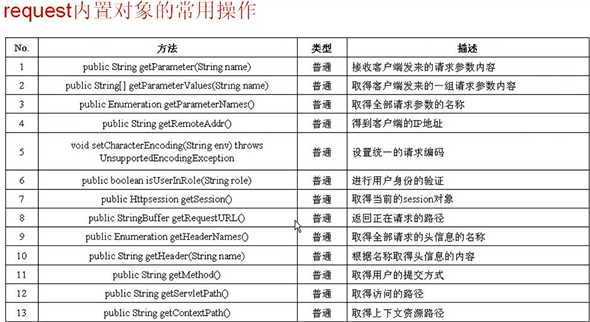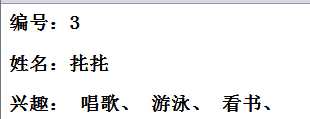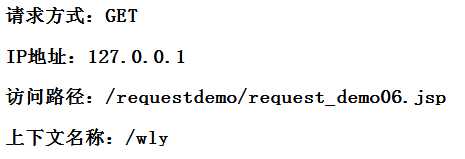使用最多,主要用来接收客户端发送而来的请求信息,他是javax.servlet.http.HttpServletRequest接口的实例化对象。
public interface HttpServletRequest extends ServletRequest
HttpServletRequest是 ServletRequest的子接口,而 ServletRequest只有这一个子接口
既然这样,为什么不能合并成一个接口呢。,长远来看,主要协议是http,如果以后有更多的协议,就直接继承 ServletRequest接口即可。

HttpServletRequest接口定义的方法很多,但是都是围绕接收客户端参数的。
回顾下客户端参数:
request_demo_01.htm:
<html>
<head><title>www.mldnjava.cn,MLDN高端Java培训</title></head>
<body>
<form action="request_demo01.jsp" method="get">
请输入信息:<input type="text" name="info">
<input type="submit" value="提交">
</form>
</body>
</html>
request_demo_01.jsp:
<%@ page contentType="text/html" pageEncoding="GBK"%>
<html>
<head><title>www.mldnjava.cn,MLDN高端Java培训</title></head>
<body>
<%
request.setCharacterEncoding("GBK") ;// 设置的是统一编码
//String content = new // String(request.getParameter("info").getBytes("ISO8859-1")) ;
String content = request.getParameter("info") ;
%>
<h2><%=content%></h2>
</body>
</html>
如下下面不加request.setCharacterEncoding("GBK")的话,会产生乱码问题。
因为request属于接收客户端的参数,所以必然有其默认的语言编码,浏览器默认UTF-8,而中文是GBK。两种编码不同,所以产生乱码。
要解决乱码问题,就要使用request提供的统一设置编码的方法setCharacterEncoding()
以后,只要进行了传递,则肯定使用这条语句进行乱码解决。
request.setCharacterEncoding("GBK") ;// 设置的是统一编码
String content = request.getParameter("info") ;
如果这种方法不能解决的话,第二种方法:
String content = new String(request.getParameter("info").getBytes("ISO8859-1")) ;
request_demo02.htm:
<html> <head><title>www.mldnjava.cn,MLDN高端Java培训</title></head> <body> <form action="request_demo02.jsp" method="post"> 姓名: <input type="text" name="uname"><br> 兴趣: <input type="checkbox" name="inst" value="唱歌">唱歌 <input type="checkbox" name="inst" value="跳舞">跳舞 <input type="checkbox" name="inst" value="游泳">游泳 <input type="checkbox" name="inst" value="看书">看书 <input type="checkbox" name="inst" value="旅游">旅游 <br><input type="hidden" name="id" value="3"> <input type="submit" value="提交"> <input type="reset" value="重置"> </form> </body> </html>
request_demo02.jsp:
注意下面inst接收方式,还有!=null的判断
<%@ page contentType="text/html" pageEncoding="GBK"%> <html> <head><title>www.mldnjava.cn,MLDN高端Java培训</title></head> <body> <% request.setCharacterEncoding("GBK") ;// 设置的是统一编码 String id = request.getParameter("id") ; String name = request.getParameter("uname") ; String inst[] = request.getParameterValues("inst") ; %> <h3>编号:<%=id%></h3> <h3>姓名:<%=name%></h3> <h3>兴趣: <% if(inst != null) { for(int x=0;x<inst.length;x++){ %> <%=inst[x]%>、 <% } } %> </h3> </body> </html>
结果:

需要注意的是,参数是表单传递过来的,也就是说传递文本,密码,单选,复选,可以还有一种参数传递的方法,叫做地址重写。

例子: request_demo03.jsp:
<%@ page contentType="text/html" pageEncoding="GBK"%> <html> <head><title>www.mldnjava.cn,MLDN高端Java培训</title></head> <body> <% request.setCharacterEncoding("GBK") ;// 设置的是统一编码 String param1 = request.getParameter("name") ; String param2 = request.getParameter("password") ; %> <h3>姓名:<%=param1%></h3> <h3>密码:<%=param2%></h3> </body> </html>
在运行的时候,必定为null,地址重写需要在地址栏输入以下内容;
http://localhost:8080/wly/requestdemo/request_demo03.jsp?name=hello&password=mldn
结果可以写入:

学习表单的时候,知道有两种提交形式,get,post,区别:
在request中有个很重要的方法:getParameterNames().返回所有参数的名字。
request_demo04.htm;
<html> <head><title>www.mldnjava.cn,MLDN高端Java培训</title></head> <body> <form action="request_demo04.jsp" method="post"> 姓名: <input type="text" name="uname"><br> 性别: <input type="radio" name="sex" value="男" CHECKED>男 <input type="radio" name="sex" value="女">女<br> 城市: <select name="city"> <option value="北京">北京</option> <option value="天津">天津</option> <option value="洛阳">洛阳</option> </select><br> 兴趣: <input type="checkbox" name="**inst" value="唱歌">唱歌 <input type="checkbox" name="**inst" value="跳舞">跳舞 <input type="checkbox" name="**inst" value="游泳">游泳 <input type="checkbox" name="**inst" value="看书">看书 <input type="checkbox" name="**inst" value="旅游">旅游<br> 自我介绍:<textarea cols="30" rows="3" name="note"></textarea><br> <input type="hidden" name="uid" value="1"> <input type="submit" value="提交"> <input type="reset" value="重置"> </form> </body> </html>
request_demo04.jsp:
<%@ page contentType="text/html" pageEncoding="GBK"%> <%@ page import="java.util.*"%> <html> <head><title>www.mldnjava.cn,MLDN高端Java培训</title></head> <body> <% request.setCharacterEncoding("GBK") ;// 设置的是统一编码 Enumeration enu = request.getParameterNames() ; %> <table border="1"> <tr> <td>参数名称</td> <td>参数内容</td> </tr> <% while(enu.hasMoreElements()){ String paramName = (String) enu.nextElement() ; %> <tr> <td><%=paramName%></td> <td> <% if(paramName.startsWith("**")){ // 是以**开头 String paramValue[] = request.getParameterValues(paramName) ; for(int x=0;x<paramValue.length;x++){ %> <%=paramValue[x]%>、 <% } } else { String paramValue = request.getParameter(paramName) ; %> <%=paramValue%> <% } %> </td> </tr> <% } %> </table> </body> </html>
普通接收参数:String paramValue = request.getParameter(paramName) ;
复选框接收参数:String paramValue[] = request.getParameterValues(paramName)
此类操作一般都是在表单不确定的时候使用,比如购物车的设计。
要取得头信息的名称通过request的getHeaderNames(),要取出每个头信息的内容,需要使用getHeader()方法
<%@ page contentType="text/html" pageEncoding="GBK"%> <%@ page import="java.util.*"%> <html> <head><title>www.mldnjava.cn,MLDN高端Java培训</title></head> <body> <% Enumeration enu = request.getHeaderNames() ; // 取得全部的头信息 while(enu.hasMoreElements()){ String headerName = (String) enu.nextElement() ; String headerValue = request.getHeader(headerName) ; %> <h5><%=headerName%> --> <%=headerValue%></h5> <% } %> </table> </body> </html>
运行结果:
host --> localhost:8080 connection --> keep-alive accept --> text/html,application/xhtml+xml,application/xml;q=0.9,image/webp,*/*;q=0.8 upgrade-insecure-requests --> 1 user-agent --> Mozilla/5.0 (Windows NT 6.1) AppleWebKit/537.36 (KHTML, like Gecko) Chrome/45.0.2454.101 Safari/537.36 referer --> http://localhost:8080/wly/requestdemo/ accept-encoding --> gzip, deflate, sdch accept-language --> zh-CN,zh;q=0.8 cookie --> JSESSIONID=7E97BB870F530DA079659225E1C4D6FC
理解即可,很少操作头信息的。
Tomcat安装时曾经设置过一个用户名和密码都是admin,那个登录验证框可以通过程序实现:isUserInRole(),相当于在tomcat新增用户,如果要增加用户,使用修改配置文件tomcat-users.xml即可。
<?xml version=‘1.0‘ encoding=‘utf-8‘?> <tomcat-users> <role rolename="manager"/> <role rolename="admin"/> <role rolename="mldnuser"/> <user username="lixinghua" password="mldnjava" roles="admin"/> <user username="admin" password="admin" roles="admin,manager"/> <user username="mldn" password="mldn" roles="mldnuser"/> </tomcat-users>
还要改web.xml;
<security-constraint>
<web-resource-collection>
<web-resouce-name>RegisteredUsers </web-resouce-name>
<url-pattern>/requestdemo/security.jsp
</url-pattern>
</web-resource-collection>
<auth-constraint>
<role-name>mldnuser</role-name>
<role-name>admin</role-name>
</auth-constraint>
</security-constraint>
<login-config>
<auth-method>BASIC</auth-method>
<realm-name>Registered Users</realm-name>
</login-config>
<security-role>
<role-name>mldnuser</role-name>
</security-role>
<security-role>
<role-name>admin</role-name>
</security-role>
下面编写角色验证代码:
security.jsp:
<%@ page contentType="text/html" pageEncoding="GBK"%> <%@ page import="java.util.*"%> <html> <head><title>www.mldnjava.cn,MLDN高端Java培训</title></head> <body> <% if(request.isUserInRole("admin")){ %> <h2>欢迎光临!</h2> <% } %> </table> </body> </html>
<%@ page contentType="text/html" pageEncoding="GBK"%> <%@ page import="java.util.*"%> <html> <head><title>www.mldnjava.cn,MLDN高端Java培训</title></head> <body> <% String method = request.getMethod() ; String ip = request.getRemoteAddr() ; String path = request.getServletPath() ; String contextPath = request.getContextPath() ; %> <h3>请求方式:<%=method%></h3> <h3>IP地址:<%=ip%></h3> <h3>访问路径:<%=path%></h3> <h3>上下文名称:<%=contextPath%></h3> </table> </body> </html>
结果:
注意:直接输入地址属于get提交!!!

对于request中的getContextPath()方法时非常重要的操作,以后可以通过它,解决路径跳转问题。解决
src=../image/1024.jpg问题
other.jsp:
<%@ page contentType="text/html" pageEncoding="GBK"%> <%@ page import="java.util.*"%> <html> <head><title>www.mldnjava.cn,MLDN高端Java培训</title></head> <body> <%=request.getContextPath()%>/images/1024.jpg <img src="<%=request.getContextPath()%>/images/1024.jpg"> </body> </html>
原文:http://www.cnblogs.com/wujixing/p/4950669.html